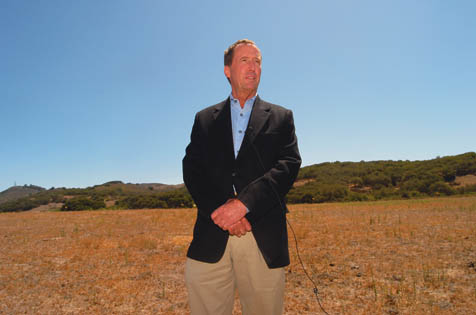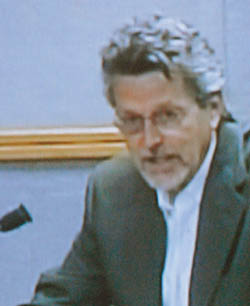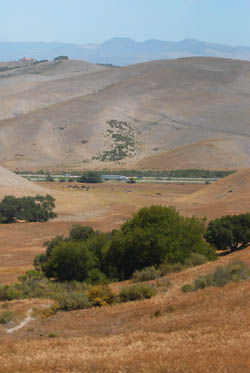North Hills Development Does Not Pass ‘Go’
The Bigger They Come. . .

What came billed as the biggest, most innovative, and certainly the most “sustainable” development ever proposed in the history of Santa Barbara County failed to make it out of the starting blocks on June 12, as the Santa Barbara County Planning Commission voted 4-1 against it in a decision that managed to be procedurally minor and momentous simultaneously.
In their concluding remarks, the commissioners expressed concern about the advisability of locating as many as 7,500 new homes-plus 2 million square feet of commercial space-on North County land currently hosting 177 active oil wells with 96 more soon on the way. Likewise, several commissioners expressed serious misgivings about rezoning 4,000 acres of land now zoned for commercial agriculture and giving it up to urban development. And while the developers-North Hills, LLC-hired one of the most creative and persuasive urban planners in the United States to design their proposal, they were ultimately undone by the lobbying blitz against the project by a small independent oil operation that owns the subsurface mineral rights to a swath of land on the property’s southern end. That oil company, Santa Maria Phoenix (SMP), was worried that the presence of roughly 20,000 new residents would compromise its ability to extract petrochemical wealth. In the week preceding Tuesday’s hearing, SMP representatives met with at least three of the commissioners to make their case.
The actual import of Tuesday’s vote remains unclear. Procedurally, the Planning Commission was charged with recommending to the county Board of Supervisors whether to initiate a study of the unprecedented changes to the county’s General Plan needed for the North Hills development proposal, as it’s been dubbed, to be submitted for consideration and review. The commission’s vote, however stinging it was to developers Randy Wheeler (pictured above) and Jackson Washburn, was technically only advisory. The supervisors are free to disregard the Planning Commission’s recommendation, though to do so with such a controversial project carries political risk. The supervisors are scheduled to hear the matter on July 10. Whether the developers intend to show up on that date remains unknown.

Champions of the North Hills development contended it would provide 1,500 units of affordable housing, save prime farmland from development, and create a new urban paradigm based on building villages. Led by the charismatic and visionary Peter Calthorpe, the reigning rock star of American urban planning, supporters waxed rhapsodic about how North Hills would be defined by human scale, walkability, mixed use, diversity, community, and sustainability. Gone would be traditional, cookie-cutter suburban sprawl. Furthermore, the new homes would be “tucked and nestled” into the North County hillsides like something straight out of Tuscany. And not incidentally, many union activists spoke approvingly of the jobs the development would create.

Critics of the proposed development-which promised to cluster the proposed 7,500 homes around five urban villages-countered that the North Hills plan constituted a glorified version of leapfrog development and urban sprawl that would transform Santa Maria’s pastoral hillsides into a Santa Barbara version of the Orange County nightmare. The roads would be choked with thousands of new drivers. Endangered wildlife, like the tiger salamander, would be further imperiled. And the county’s iconic oak savannas would be sliced and diced by new roads. That the county would consider planting a new urban center right in an agrarian nowhere-miles away from any urban limit line, they charged-constituted a dangerous departure from traditional planning doctrines that for 27 years sought to protect agriculture from urban encroachment.
From the start, the plan to initiate the North Hills study got some of its strongest support from County Executive Mike Brown, who has never been shy about his enthusiasm for new urban centers. Assistant county planning chief Dianne Black also recommended approval of the study and reminded the commissioners that a Board of Supervisors-created task force had unanimously endorsed the idea of new urban villages. During a drive-through tour of the site last Thursday, Black noted that there were only three ways to accommodate Santa Barbara County’s projected growth. “We can build up, out, or new,” she said. “And we’ve already tried the first two.” The county’s traditional approach to urban expansion-in-fill development-has been stymied, Black said, by political resistance by slow-growthers opposed to increased housing densities and to new state edicts demanding the zoning changes necessary to build more affordable housing.
Certainly, it was not lost on Brown or Black that there would be few complaining neighbors among the oaks and oil derricks of the North Hills development site. Beyond that, Brown has been intrigued by the possibility of new urban centers as revenue generators for a county government beset by fiscal shortfalls and unfunded mandates. As the parched grazing lands of North Hills were replaced with housing, the county might benefit from the tax revenues levied on the newly constructed real estate. Assuming an average selling price of $600,000 per home, that would be $4.5 billion in new real estate for the county to tax.
While Tuesday’s outcome didn’t shake supporters of either side from their beliefs, it is now uncertain whether the county will undertake the multimillion dollar studies-to be funded by Wheeler and Washburn-to see which side is better supported by the facts. For example, Washburn claimed his company, Breitburn Energy-which bought the 4,000 acres in 2004-has perfected state-of-the-art technology allowing its employees to pump silently, fumelessly, and continuously within 60 feet of the nearest home. Washburn said Breitburn has such operations located next to Beverly Hills High School and Cedars-Sinai Medical Center in Los Angeles, as well.

Air Pollution Control District (APCD) officials were nervous, however. Although they did not testify Tuesday, they have made clear their concerns: Breitburn’s North Hills oil production is now the third-largest generator of air pollution in the county-beating out ExxonMobil’s facilities at Las Flores Canyon as well as Venoco’s Ellwood plant. Furthermore, APCD officials worry about the high concentrations of hydrogen sulfide at the site. At 1,000 parts per million, it causes death. More commonly however, it becomes a chronic nuisance for whatever public agency responds to calls from neighbors complaining about gas stinking of rotten eggs.
And then, of course, there are chronic legal woes now consuming the Santa Maria courts, in which homeowners unhappily discover that their backyard soil remains contaminated by the old oil fields that once defined the Santa Maria Valley. Health ailments-real and imagined-have triggered a chain reaction of prolonged legal warfare. North Hills consultants claim oil operations there were relatively pristine, but it’s hard to know how much contamination has been buried in the course of North Hills’ 100-year history with oil.
Although Black supported the study, she wound up framing the question for the commissioners in such a way that helped them reject it. She told them if they couldn’t support a housing development in the middle of agriculturally zoned land or if they didn’t think oil and people should be mixed in close quarters, they should reject the study. And that’s just what they did.
Third District Commissioner and Brooks Firestone appointee David Smyser spoke first. He said he felt activist opposition would prevent the county from meeting housing requirements via traditional urban in-fill development but that he doubted the new affordable housing promised by North Hills would dip significantly below what the market would bear. “It has never happened,” Smyser said. “Never.” He also warned that the infrastructure costs associated with building a huge development in the “middle of nowhere” would be so staggering that Santa Barbara County, not the developer, would invariably pay for much of it. Instead of cannibalizing existing ag land, why not take the development to an existing rural community, he asked. “Why don’t we go to New Cuyama and give them what they’ve been asking for all these years?” he asked.
Daniel Blough, appointed by 5th District Supervisor Joe Centeno, said he couldn’t support anything that might impinge on the development of oil and gas. Second District Commissioner Cynthia Brown-appointed by Supervisor Janet Wolf-noted that West Goleta residents are already playing duck-and-cover when the hydrogen sulfide sirens go off, and that she hesitated to inflict that fate on North Hills’ proposed residents. Likewise, she noted that existing zoning already allowed for the construction of 30,000 units. First District Commissioner Michael Cooney-appointed by Supervisor Salud Carbajal-said he didn’t want to take sides in a squabble between two rival oil companies. He also said the “village concept” had promise but objected that the commercial center would inflict violence to the nearby views.
The only commissioner to speak in favor of the project was Joe Valencia, appointed by 4th District Supervisor Joni Gray. Valencia lamented that more people worried about the fate of the tiger salamander than about the 35 million Americans living in poverty. “We are the real endangered species,” he declared. “We have to start looking out for ourselves.” To that end, he noted that two of his five children-all of whom he said were professionals-still could not afford a house in Santa Barbara’s prohibitive housing market. “Who has the $125,000 you need to make a down payment these days?” he asked. “We need more housing.”


